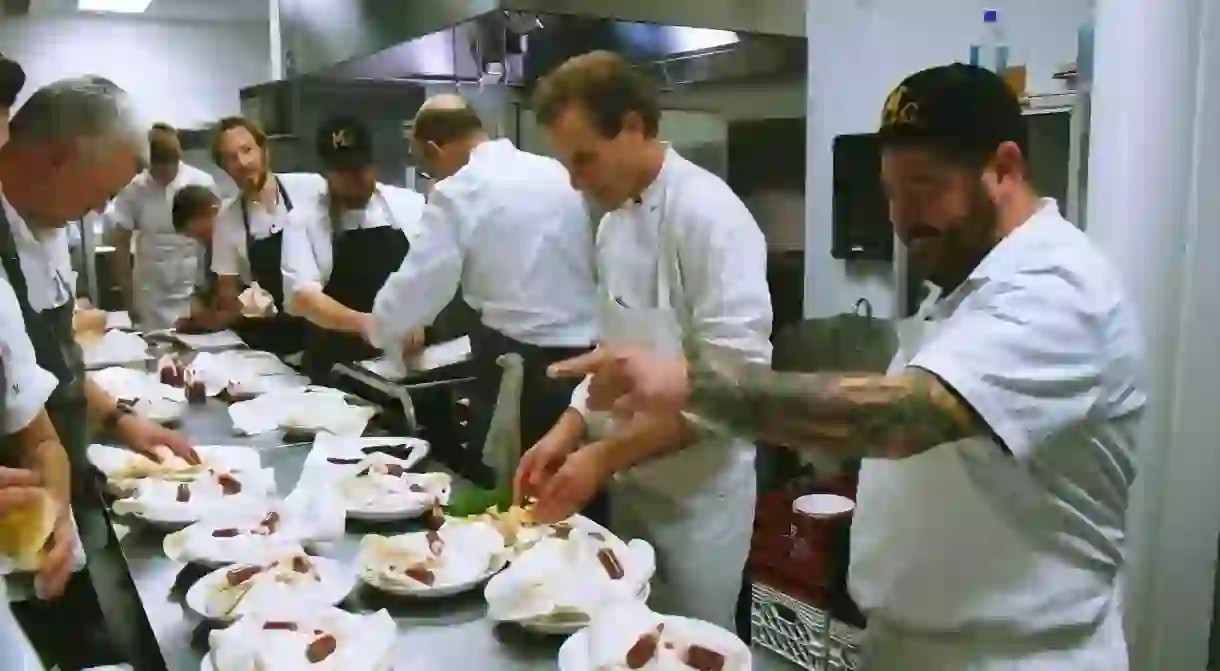Anthony Bourdain Examines Culinary Sustainability In “Wasted!: The Story of Food Waste”

Environmentalists and fine-dining fans alike will be enthralled by this plucky documentary showcasing solutions to one of the most vexing problems of the 21st century.
Did you know that it takes up to 25 years for a head of lettuce to decompose in a landfill?
That’s one of the alarming stats dropped in Wasted!: The Story of Food Waste, a food waste-focused documentary hosted by food personality Anthony Bourdain.
Plenty of unnerving info is woven into the film. In the U.S., 40% of the food that’s produced goes to waste, it tells us. More than 90% of wasted food in this country ends up in landfills—the worst possible situation, because instead of biodegrading quickly and innocuously as it would if composted, it instead produces methane, one of the most damaging greenhouse gases.
The annual cost of food waste is one trillion dollars. What’s more, the 1.3 billion tons of food that are wasted each year, if redistributed, could end hunger among the people of the world who currently don’t have enough to eat. And that’s just for starters.
Instead of merely relaying terrifying statistics and gloom-and-doom predictions, however, Wasted! maintains a remarkably upbeat and optimistic tone. It focuses on solutions to the planet’s food waste issues, rather than the problems themselves. We could all be doing more to ensure food doesn’t end up in landfills, it tells us, and then turns to people like Mario Batali, Massimo Bottura, Danny Bowien, and Dan Barber to show us how.

After all, as Bourdain points out in a statement, chefs, more than any others, are leading the anti-waste charge because they’re “painfully aware of the egregious volume of perfectly usable, nutritious food that could otherwise feed people in need” that’s thrown out in their restaurants every day.
“I don’t like the idea of being an advocate,” he tells the camera at the beginning of the film. But during his time, years ago, as a culinary student and young chef, one notion was emphasized over and over to him: “Use everything, waste nothing.” He felt compelled to act, as did many of his food-world compatriates.
Barber, one of the chefs spearheading the anti-waste movement, says some of the most beloved dishes of the world’s greatest cuisines utilize items that would otherwise be thrown out. For instance, bouillabaise is basically a “stew of reject fish,” he says. Prosciutto de Parma is essentially a waste-fed pig. It makes sense for those in charge of modern America’s cuisine to take the same approach.

Wasted! will appeal to environmentally minded viewers for sure. It also includes enough food-world superstars to make it a must-watch for the same audiences addicted to Bourdain’s Parts Unknown (produced, not coincidentally, by the same team that made this film) or Chef’s Table, or who fight for reservations at multi-Michelin-starred restaurants.
At times, I found this to be one of the film’s downfalls: It can lapse into a slightly elitist tilt. It makes for good food-porn (again going back to Parts Unknown) to see chef Danny Bowien eating his way through an omakase menu of unmentionable bits in Japan, but I’d argue that’s not helpful in the context of Wasted! Not everyone will relate, meanwhile, to Dave Pasternak venturing to Montauk’s fishing docks to chat with the fishermen from whom he procures his seafood for Esca; that’s a luxury afforded only to top-level, well-connected chefs in a few parts of the U.S.
Likewise, as fascinating as it is to see Dan Barber, one of the spearheads of the anti-waste movement, talking with his farmers and leading his chefs at Blue Hill at Stone Barns through a tasting of vegetable stalks and stems, trying the dishes he creates with these produce cast-offs is something only few will ever be able to do. This type of dining simply isn’t possible in much of the country, nor is it achievable to people with ordinary dining budgets. The “trash fish” Pasternak has relabeled on Esca’s menu to sound more appealing to diners and, thus, more sellable? It still goes for about $45 a plate. The tasting-menu dinners Barber serves at his truly exquisite Stone Barns restaurant go for $258 a person.
Maybe the chefs’ anti-waste measures are intended to “trickle down” through the restaurant industry, or be inspirational as well as aspirational. But it may rub viewers the wrong way to be told these are steps we can “all” take.
Some of the other waste-reduction strategies we see are large-scale; some are small. Some are adaptable only by large companies and high-end restaurants and elite farmers; some are things that anyone can do. We witness a major food producer turning waste into gas that powers a generator for electricity; we see schoolchildren composting at a school.

Above all, the film provides the eye-opening epiphany that doing what you can to reduce food waste simply makes sense. It saves money. It reduces the effects of climate change. It makes more food available to those in need. It can also taste really, really good. And you’ll think twice before ever throwing out so much as a banana peel again.
Wasted!: The Story of Food Waste is in theaters and on-demand from October 13, 2017.













